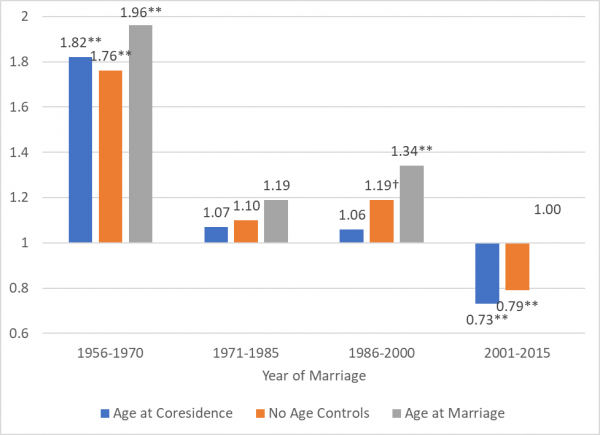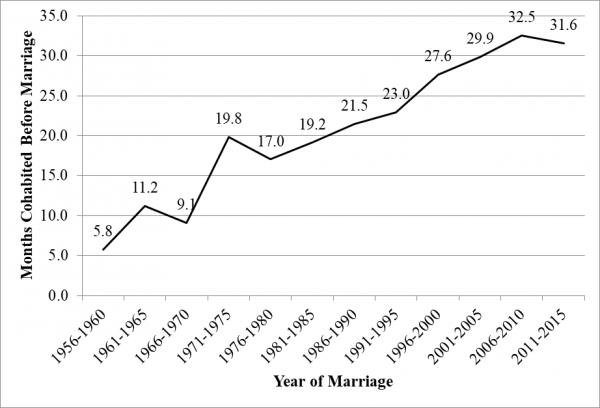A new article published in Journal of Marriage and Family examines the relationship of cohabitation and divorce, and claims that recent research that finds that premarital cohabitation does not impact divorce rates is incorrect. They find that in the first year of marriage, premarital cohabitation is associated with lower divorce rates compared to those who directly marry (because those who would have divorced quickly are filtered out by premarital cohabitation), but that afterwards premarital cohabitation is associated with higher divorce rates. These effects “cancel each other out,” making it appear as if cohabitation is not associated with divorce, when, according to them, it still is; just not in very early marriage.
However this research makes an important omission. They account for the age at which women married their first husband, but don’t account for the age at which they moved in together. As my past research has shown, accounting for age at marriage but not the age at which couples moved in together artificially inflates the association between premarital cohabitation and divorce for recent cohorts, compared to statistical models that account for the age at which couples moved in together, or even statistical models that do not account for age at all.
This inflation happens because the older that couples are when they move in together with the person they will eventually marry (whether at marriage or beforehand) the less likely they are to divorce. When accounting for age at marriage only, researchers are comparing couples who married directly at, for example, age 24, to those who moved in together at perhaps age 21 and then married at age 24.
My research argues that a more accurate comparison would compare those who moved in together at, for example, 21 (and then eventually married) to those who both moved in together and married at age 21. When doing so, the relationship between premarital cohabitation and divorce disappears for some cohorts; and in very recent cohorts, as I show in my recent CCF report, reverses, with premarital cohabitors having a lower risk of divorce compared to couples that marry directly. In other words, the reason premarital cohabitors seem to have a higher risk of divorce is not because cohabitation causes divorce; it’s because premarital cohabitors who eventually marry select partners and move in together at earlier ages compared to other couples who marry at the same age, when they are less prepared for the roles and responsibilities that are associated with eventual successful marriages.
To demonstrate the importance of how researchers account for age on research findings, I recalculated the odds ratios for the relationship of premarital cohabitation and divorce that I present in my recent CCF report on changing cohabitation over time (which accounts for age at coresidence), in statistical models that either account for age at marriage instead, or don’t account for age at all. As you can see in Figure 1 below, models that account for age at marriage show a stronger association between cohabitation and divorce. In the most recent cohort, this effect appears neutral, but when accounting for age at coresidence instead (or even if not accounting for age at all) premarital cohabitation is associated with a lower risk of divorce.
Figure 1: Odds Ratios for the Association Between Premarital Cohabitation and Divorce in First Marriages in Four Cohorts: The Importance of Age Controls
Note: Numbers calculated from the 1988 National Survey of Families and Households (1956-1985, N=3,594) and National Survey of Family Growth (1986-2015, N=9,420) using Cox regressions and based on women <36 at first marriage. Controls for raised not religious, religious attendance, race, education at marriage, mother’s education, prior cohabitations, lived with both biological parents at age 14, birth prior to coresidence, began coresidence while pregnant. Age at Coresidence models additionally control for age at coresidence and age at coresidence squared. Age at Marriage models additionally control for age at marriage and age at marriage squared. †p<.10, **p<.01
In my new article recently published in the journal Marriage & Family Review I show that the length of time that couples live together before marriage has grown in recent decades (See Figure 2), increasing the importance of correctly accounting for the age at which couples move in together, as it grows further and further from the age at which these couples marry.
Figure 2: Average Duration of Premarital Cohabitation with First Husband among Premarital Cohabitors who Married before Age 36 (Months)
While the overall pattern in this new research of lower divorce rates in the first year of marriage after cohabitation seems plausible, accounting for age at marriage rather than age at coresidence artificially inflates the divorce rates of premarital cohabitors across all marriage durations, calling into question whether premarital cohabitation is in fact associated with higher divorce risks at later marriage durations, as found by the authors. A comparison that accounted for age at coresidence instead of age at marriage would likely have led to significantly different findings.
Arielle Kuperberg is Associate Professor and Director of Undergraduate Studies in Sociology and Cross-Appointed Faculty in the Women and Gender Studies Program at the University of North Carolina at Greensboro. Follow her on twitter at @ATKuperberg and reach her at atkuperb@uncg.edu.



Comments